I was wondering about three things:
Wind chill effect. Human body perceives surrounding temperature as colder, with increasing air flow:
This is understandable, as thermal transfer "consists" of convection, diffusion and radiation.
I assume that in real world example, we are being "chilled" by fan due to our skin not being 100% dry, and thus wind speed increases convection. Is this assumption correct?
Imagine hypothetical situation with no precondition- human is standing in vast open space somewhere on earth, naked. Air temperature is exactly 36.6℃, there is no wind and for the sake of experiment I assume that sun does not shine, so basically I assume that this is near thermal equilibrium (human body generates energy from metabolic processes). I also assume that this man's body has 36.6℃ on whole surface.
Will perceived temperature to this man heavily dependent on air humidity? Why, most probably, will he/she feel that it is very hot?Same situation, but air humidity is 100%, basically a sauna. Yet, wind is also extremely strong, say 110 km/h or 70 mph. Man should feel cold according to wind chill, but how it is possible(to feel cold in such conditions), since fluid (air) that has contact with his/her skin has same temperature as his body? (Assume convection/ would be relatively small because there is no thermal gradient, and diffusion would be relatively small because of high air humidity).


